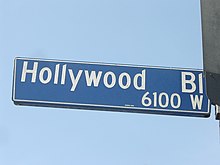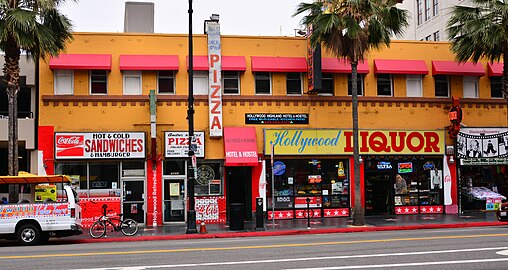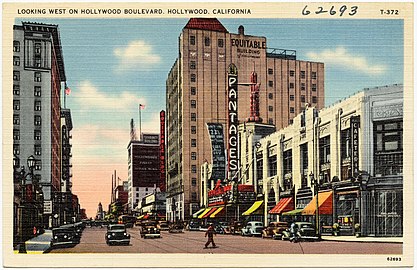|
Hollywood Boulevard
Hollywood Boulevard is a major east–west street in Los Angeles, California. It runs through the Hollywood, East Hollywood, Little Armenia, Thai Town, and Los Feliz districts. Its western terminus is at Sunset Plaza Drive in the Hollywood Hills and its eastern terminus is at Sunset Boulevard in Los Feliz. Hollywood Boulevard is famous for running through the tourist areas in central Hollywood, including attractions such as the Hollywood Walk of Fame and the Ovation Hollywood shopping and entertainment complex. Route descriptionHollywood Boulevard's western terminus is at Sunset Plaza Drive in the Hollywood Hills. It then runs as a winding residential street down to Laurel Canyon Boulevard. The boulevard then proceeds due east as a major thoroughfare through Hollywood and its popular tourist areas. Part of this segment has been listed in the U.S. National Register of Historic Places as part of Hollywood Boulevard Commercial and Entertainment District. The fifteen blocks between La Brea Avenue east to Gower Street is part of the Hollywood Walk of Fame. The Ovation Hollywood shopping and entertainment complex, the home of the Dolby Theatre, is located at the corner of Hollywood Boulevard and Highland Avenue. And the intersection with Vine Street was once a symbol of Hollywood itself. East of Gower Street, Hollywood Boulevard crosses the Hollywood Freeway (US 101) before running through East Hollywood. The portion of the boulevard between the Hollywood Freeway and Vermont Avenue forms the northern boundary of Little Armenia,[1] while the portion between Western Avenue and Sunset Boulevard forms part of the southern boundary of Los Feliz.[2] Thai Town is centered along the six blocks of Hollywood Boulevard between Western and Normandie Avenues.[3] After crossing Vermont Avenue, Hollywood Boulevard heads southeast to its eastern terminus at Sunset Boulevard. Three B (Red) Line Metro Rail stations are located on Hollywood Boulevard: Hollywood/Highland station, Hollywood/Vine station, and Hollywood/Western station. History1890s to 1910Part of today's Hollywood Boulevard was called Prospect Avenue, a dusty road that ran through Hollywood towards the neighboring city of Los Angeles. In December 1899, a new railroad construction began to connect Hollywood with Los Angeles in a project that was led by Peter Beveridge, H.J. Whitley, and Griffith J. Griffith. In May 1900, the railroad connecting Hollywood and Los Angeles was completed, and another one was under construction. In 1901, the Town of Hollywood opened the new macadamized road surface with electric railway that ran down its center between Laurel Canyon and Western. Eventually, the road was widened from 20 feet wide to almost 100 feet wide in some areas.[4] In 1903, Hollywood became a municipality, and Prospect Avenue became sometimes called as the Boulevard of Hollywood, albeit unofficially. In 1910, the town of Hollywood was incorporated into Los Angeles, and Prospect Avenue was officially renamed Hollywood Boulevard. 1920sIn the early 1920s, real estate developer Charles E. Toberman (the "Father of Hollywood") envisioned a thriving Hollywood theater district.[5] Toberman was involved in 36 real estate development projects while building the Max Factor Salon, Hollywood Roosevelt Hotel and the Hollywood Masonic Temple. He partnered with Sid Grauman, and they opened the three themed theaters: Egyptian, El Capitan ("The Captain") (1926), and Chinese.[6] Regional shopping districtStarting around 1920, the boulevard and adjacent streets became a major regional shopping district, both for everyday needs and appliances, but increasingly also for high-end clothing and accessories, in part because of the nearby film studios. Chains that opened includes Schwab's in 1921, Mullen & Bluett in 1922, I. Magnin in 1923, Myer Siegel in 1925, F. W. Grand and Newberry's (dime stores) in 1926–8, and Roos Brothers in 1929. The independent Robertson's department store, at 46,000 square feet (4,300 m2) and 4 stories tall, opened in 1923. In 1922, stock was sold to finance construction of a much larger department store at Hollywood and Vine,[7] originally to have been a Boadway Bros. When Boadway's went out of business the next year, B. H. Dyas, a Downtown Los Angeles–based department store,[8] opened in the 130,000-square-foot (12,000 m2) building in March 1928, then sold their lease to The Broadway in 1931 – the building still a landmark today, known as the Broadway Hollywood Building. By 1930 the shopping district consisted of over 300 stores.[9] The area would later face competition from areas along Wilshire Boulevard: the easternmost around Bullocks Wilshire which opened in 1929, second the Miracle Mile, and finally, the shopping district of Beverly Hills, where Saks Fifth Avenue opened a store in 1938. Map of businesses in the shopping district at its peak c.1925–8The following diagram, based on an artistic map by the Hollywood Boulevard Association, and on newspaper advertisements[10] shows the major businesses along Hollywood Boulevard, from the intersection with Vine Street to the intersection with La Brea Avenue, in 1927 or 1928. There are a few relevant notes about major buildings added after 1928. Numbers from 6100–7200 are addresses on Hollywood Boulevard. Dates indicate years of opening, except dates with an asterisk indicate that the establishment was in operation that year according to the source document consulted.
1940s to 1960sIn 1946, Gene Autry, while riding his horse in the Hollywood Christmas Parade — which passes down Hollywood Boulevard each year on the Sunday after Thanksgiving — heard young parade watchers yelling, "Here comes Santa Claus, here comes Santa Claus!" and was inspired to write "Here Comes Santa Claus" with Oakley Haldeman.[29] In 1958, the Hollywood Walk of Fame, which runs from La Brea Avenue east to Gower Street (and an additional three blocks on Vine Street), was created as a tribute to artists working in the entertainment industry. DeclineIn the 1970s, the street became very seedy and was frequented by many odd characters as shown in pictures by photographer Ave Pildas.[30] RevitalizationIn 1984, a portion of Hollywood Boulevard was listed in the National Register of Historic Places as part of the Hollywood Boulevard Commercial and Entertainment District.[31] In 1992, the street was paved with glittery asphalt between Vine Street and La Brea Boulevard.[32] The El Capitan Theatre was refurbished in 1991 then damaged in the 1994 Northridge earthquake. The full El Capitan building was fully restored and upgraded in December 1997. The Hollywood Entertainment District, a self-taxing business improvement district, was formed for the properties from La Brea to McCadden on the boulevard.[6] The Hollywood extension of the Metro Red Line subway was opened in June 1999, running from Downtown Los Angeles to the San Fernando Valley. Stops on Hollywood Boulevard are located at Western Avenue, Vine Street, and Highland Avenue. Metro Local lines 180 and 217 also serve Hollywood Boulevard. A light rail extension station is proposed at the Hollywood Blvd. and Highland Ave. intersection connection the boulevard with West Hollywood, Central LA and LAX. An anti-cruising ordinance prohibits driving on parts of the boulevard more than twice in four hours.[33] Beginning in 1995, then Los Angeles City Council member Jackie Goldberg initiated efforts to clean up Hollywood Boulevard and reverse its decades-long slide into disrepute.[34] Central to these efforts was the construction of the Hollywood and Highland Center and adjacent Dolby Theatre (originally known as the Kodak Theatre) in 2001. In the summer of 2005, the city made revamping plans on Hollywood Boulevard for future tourists. The three-part plan was to exchange the original streetlights with red stars into two-headed old-fashioned streetlights, put in new palm trees, and put in new stoplights. The renovations were completed in late 2005. In the few years leading up to 2007, more than $2 billion was spent on projects in the neighborhood, including mixed-use retail and apartment complexes and new schools and museums.[34] In 2021, the Vogue Theatre, on Hollywood Boulevard, at Las Palmas, reopened as the Vogue Multicultural Museum.[35][36][37][38] Renovations of the Hollywood and Highland Center began in 2020. The renovated complex was renamed Ovation Hollywood in 2022.[39][40][41] In 2022, for the return of the LA Pride parade to the boulevard, the city installed multi colored lighting to more than 100 trees to illuminate for special events.[42] Heart of Hollywood / Walk of Fame Master PlanAdvocates promote the idea of closing Hollywood Boulevard to traffic and create a Pedestrian zone from La Brea Avenue to Highland Avenue citing an increase in pedestrian traffic including tourism, weekly movie premiers[43] and award shows closures, including 10 days for the Academy Award ceremony at the Dolby Theatre.[44] Similar to other cities in the US, like Third Street Promenade, Fremont Street in Las Vegas, Market St. in San Francisco or the closure in Times Squares Pedestrian Plaza's created in 2015.[45] In June 2019, The City of Los Angeles commissioned Gensler architects to provide a master plan for a $4 million renovation to improve and "update the streetscape concept" for the Walk of Fame between the Pantages Theater (Gower Avenue) at the east and The Emerson Theatre (La Brea Avenue) at the west end of the boulevard.[46][47][48] Los Angeles City Councilmember Mitch O'Farrell released the draft master plan designed by Gensler and Studio-MLA in January 2020. The city's Bureau of Engineers proposed a three phase approach to implement the changes. This included adding bike lanes, new landscaping, removing lanes of car traffic, sidewalk widening by removing street parking and art-deco designed street pavers to beautify the boulevard. They also proposed a street mechanism to able to temporarily close the boulevard on pedestrian high capacity days or events where a street closure was approved. Creating public plazas and car free zones. Phase three would disallow east-west travel thru the boulevard but still allow north-south travel along its major intersections, Highland Avenue, Cahuanga Boulevard and Vine Street.[49] The approved phase one was completed and removed parking lanes between Orange Drive and Gower Street in 2022.[50][51] New district council member for Hollywood, Hugo Soto-Martinez continued with the revitalization plan after defeating O'Farrell in the 2022 election cycle. A motion was filed June 30, 2023 to implement a tax district to continue funding the master plans phase two and three.[52] In early March 2024, council member Hugo Soto-Martinez announced "Access to Hollywood" plan. Commencing phase two of the proposed redevelopment. They announced the addition of bus only lanes, bikes lanes and the removal of additional street parking to add sidewalk space for pedestrians. Restructure of lanes to be completed by 2025.[53] Phase three build out has not been announced, pending funding.[54] Also in East Hollywood area, another plan for boulevard revitalization is planned. LA DOT announced "Vision Zero" in August 2023, a pedestrian friendly streetscaping redesign. LADOT's plan focuses on the eastern section of Hollywood Boulevard between Gower Street and east past Vermont Avenue. Plans are to add safety instruments, continental crosswalks and pedestrian friendly alert striping.[55] Major intersectionsThe entire route is in Los Angeles, Los Angeles County.
GalleryHistorical photos of Hollywood Boulevard
Contemporary photos of Hollywood Boulevard
Vintage post cards featuring Hollywood Boulevard
EventsA popular event that takes place on the Boulevard is the complete transformation of the street to a Christmas theme. Shops and department stores attract customers by lighting their stores and the entire street with decorated Christmas trees and Christmas lights. The street essentially becomes "Santa Claus Lane." The route of Hollywood Christmas Parade partially follows Hollywood Boulevard.[57] Landmarks
See alsoReferences
External linksWikimedia Commons has media related to Hollywood Boulevard, Hollywood. Wikiquote has quotations related to Hollywood Boulevard. KML is from Wikidata
|
|||||||||||||||||||||||||||||||||||||||||||||||||||||||||||||||||||||||||||||||||||||||||||||||||||||||||||||||||||||||||||||||||||||||||||||||||||||||||||||||||||||||


















